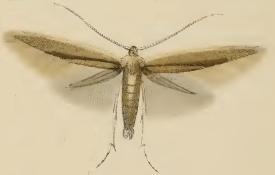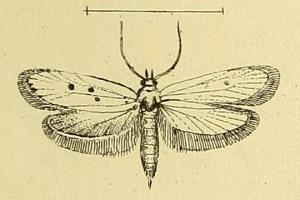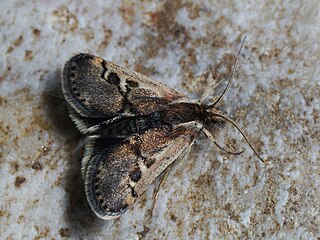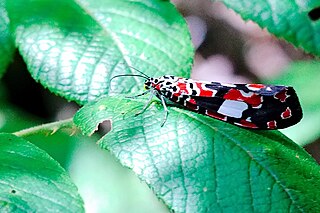
Heliotropium is a genus of flowering plants in the heliotrope family, Heliotropiaceae. There are around 325 species in this almost cosmopolitan genus, which are commonly known as heliotropes. It is highly toxic for dogs and cats.

Heliotropium arboreum is a species of flowering plant in the borage family, Boraginaceae. It is native to tropical Asia including southern China, Madagascar, northern Australia, and most of the atolls and high islands of Micronesia and Polynesia. Common names include velvetleaf soldierbush, tree heliotrope, veloutier, and octopus bush. It is a shrub or small tree typical of littoral zones reaching a height of 3.6 m (12 ft), with a spread of about 5 m (16 ft).

Udea rubigalis, the celery leaftier or greenhouse leaftier, is a member of the family Crambidae. It is found across the Americas. The species was first described by Achille Guenée in 1854.

Platyptilia gonodactyla, also known as the triangle plume, is a moth of the family Pterophoridae found in temperate Asia and Europe. It was first described by the Austrian entomologists, Michael Denis & Ignaz Schiffermüller in 1775.

Stenoptilia zophodactylus, also known as the dowdy plume, is a species of moth of the family Pterophoridae found worldwide. It was first described by Philogène Auguste Joseph Duponchel in 1840.
Atralata is a genus of moths of the family Crambidae. It contains only one species, Atralata albofascialis, which is found in most of Europe, except Ireland, Great Britain, Norway, Finland, Lithuania and Greece.

Crombrugghia distans, also known as the Breckland plume is a moth of the family Pterophoridae found in Africa, Asia and Europe. It was first described by Philipp Christoph Zeller in 1847.

Aristaea pavoniella is a moth of the family Gracillariidae. It is found from Germany and Poland to Italy, as well as central and southern Russia.

Coleophora milvipennis is a moth of the family Coleophoridae. It is found in all of Europe, east to Japan (Hokkaido).

Ochromolopis ictella is a moth of the family Epermeniidae. It is found from Finland to the Iberian Peninsula, Italy and Greece and from France to Ukraine. It is also found in North Africa.

Ethmia quadrinotella is a moth in the family Depressariidae. It is found in Greece, Turkey, Armenia, Syria, the Palestinian Territories, Iran, Iraq, Afghanistan, north-western Karakoram, Bahrain, Arabia, Tunisia, Algeria, Egypt, Morocco, Cape Verde and northern Sudan.

Titanio normalis is a species of moth in the family Crambidae. It is found in Spain, Italy, Austria, the Czech Republic, Slovakia, Hungary, Croatia, Romania, Bulgaria, the Republic of Macedonia, Greece, Belarus, Russia and Turkey.
Cynaeda gigantea is a species of moth in the family Crambidae. It is found in France, Switzerland, Croatia, Bosnia and Herzegovina, Hungary, Romania, the Republic of Macedonia, Greece and Turkey.

Epascestria pustulalis is a species of moth in the family Crambidae. It is found in large parts of Europe, except Ireland, Great Britain, Norway, Finland, Denmark, the Benelux, France, Switzerland, Portugal, Slovenia and Croatia. It is also present in the Near East, including Lebanon and Turkey.

Adscita geryon, the cistus forester, is a moth of the family Zygaenidae. It is found in southern and central Europe, east to Turkey. It is also present in Great Britain.
Acrolepiopsis vesperella is a moth of the family Acrolepiidae. It is found in Germany, France, Spain, Portugal, Italy, Croatia, Serbia and Montenegro, Greece and on the Canary Islands.

Amauris tartarea, the monk or dusky friar, is a butterfly in the family Nymphalidae. It is found in Guinea, Burkina Faso, Sierra Leone, Liberia, Ivory Coast, Ghana, Togo, Benin, Nigeria, Cameroon, Equatorial Guinea, Gabon, the Republic of the Congo, the Central African Republic, Angola, the Democratic Republic of the Congo, Sudan, Uganda, Kenya, Tanzania, Malawi, Zambia, Botswana and Namibia. The habitat consists of various types of forests.

Godyris zavaleta, the Zavaleta glasswing, is a species of butterfly of the family Nymphalidae. It is found from Costa Rica to southern Peru. The habitat consists of lowland and mid-elevation rainforests at altitudes up to 900 meters.

Utetheisa elata is a moth in the family Erebidae. It was described by Johan Christian Fabricius in 1798. It is found in Angola, South Africa and Tanzania, as well as on the Comoros, Réunion, Madagascar, Mauritius and the Seychelles.












